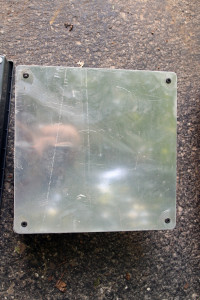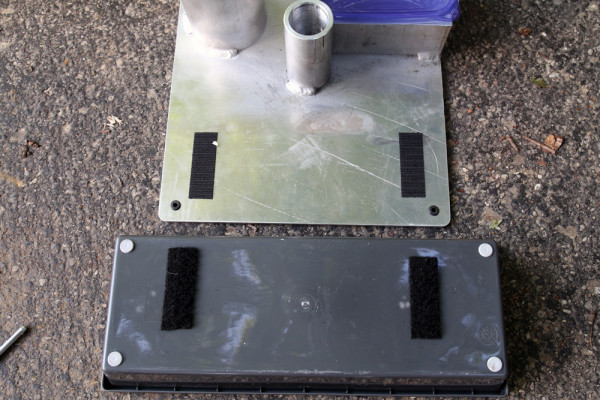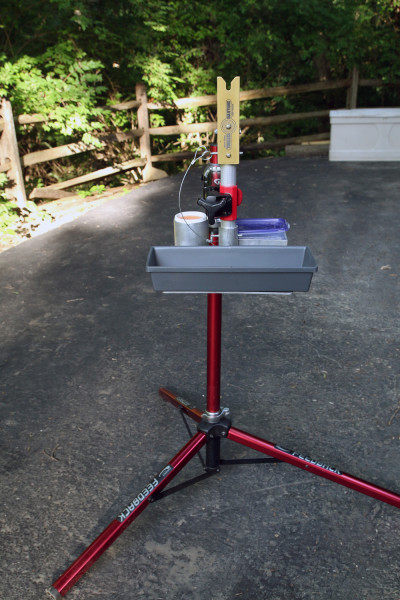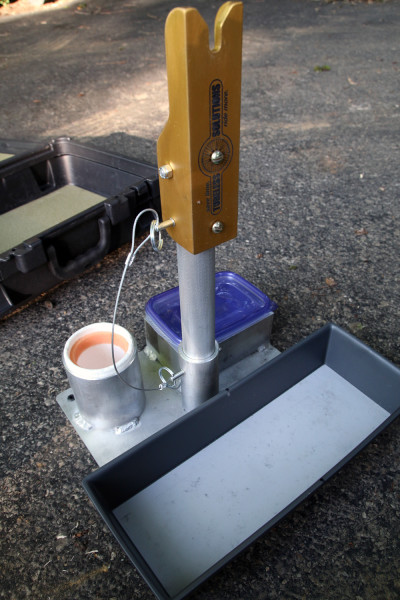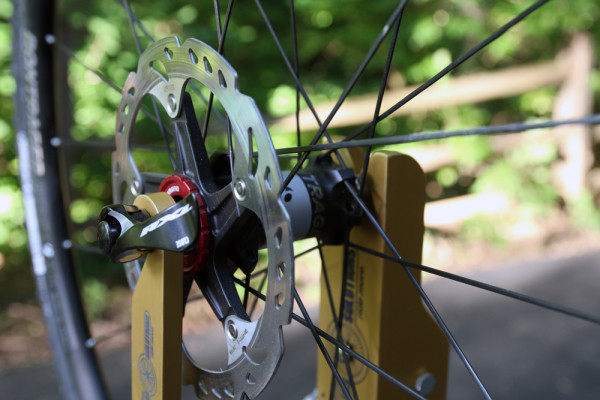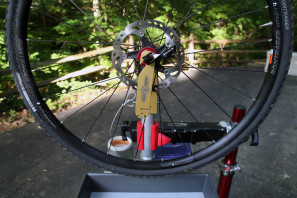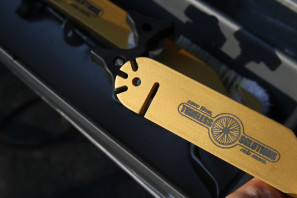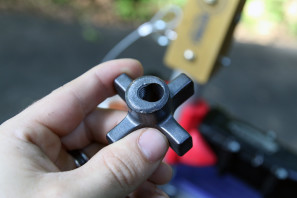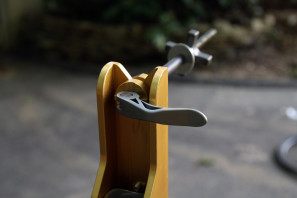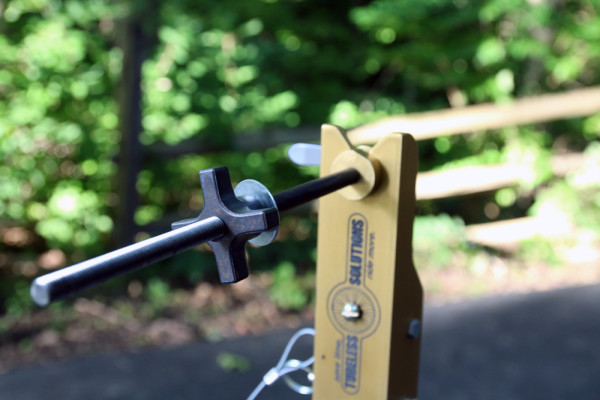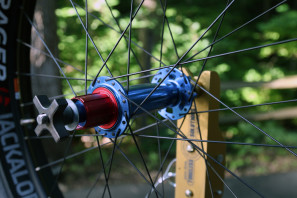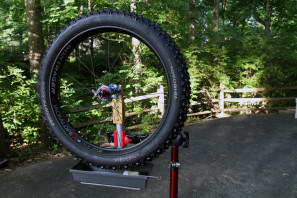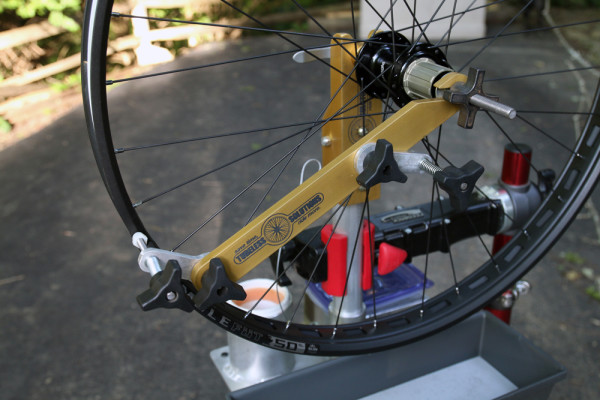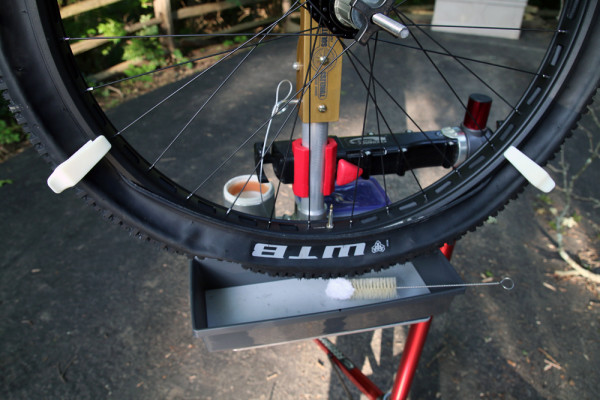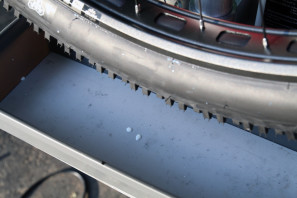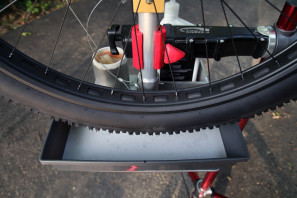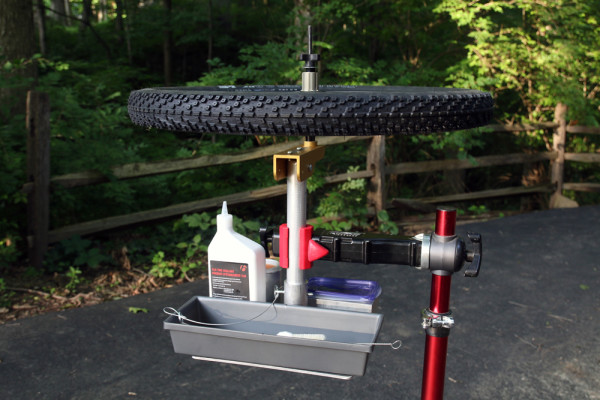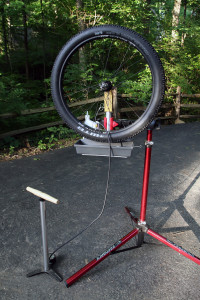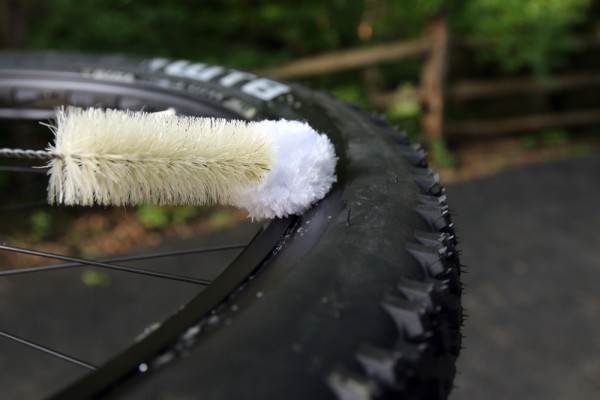Believe it or not, there are still those out there that don’t embrace tubeless technology. More surprising, is that at least according to Tubeless Solutions there are even shops out there who are uncomfortable with performing tubeless conversions. Their reasoning? Mostly the potential mess, the amount of time it takes, and the uncertainty of ensuring a complete seal before the tire walks out the door.
Like many stories behind intriguing products, the Tubeless Tower started with the thought that there had to be a better way to install tubeless tires. Roughly three years ago, Tim Voegeli and his brother Phil starting kicking around the idea and wanted to figure out a way to make the process easier. At the time Tim was riding tubeless on every one of his bikes – Phil on the other hand who is admittedly an “anal retentive electrical engineer” was still happily riding with tubes. Eventually Tim convinced Phil to give tubeless a try and after an entire year on his commuter without flats (25 miles round trip), he says he was sold.
After the first prototypes were drawn up, the design has been tweaked, put through design panels at Pitt State University, redesigned with design work and CAD modeling from their friend Byron Loibl, patented, and is finally nearing production form. Almost every step of the way, all of those involved say they were instantly sold after seeing Tim install a tire on the stand. That’s not really surprising. Even we were a bit skeptical, but once you see everything the stand does, you really will wonder why no one has thought of this before…
Just what is the Tubeless Tower and who is it for? Think of it as an all-in-one tubeless tire work shop – just add air and sealant. While the kit we were sent is still very much a prototype, the production version may be available in different models or pieced out individually. As the “Pro Model” as we’ll call it sits here, the Tubeless tower includes the shop quality base, and from left to right for the top photo – the dual locking pin, Wheel Truing Adapter hook, Thru Axle Adapter, Tire Brush, Tower Extension, Hook Tool, and Rim Clip Tire Tools and the Rim Clips. Everything packs neatly in the ABS plastic case which brings up an interesting point with the Tubeless Tower – with room for a C02 filling device and sealant in the case, this is a truly portable tubeless work station.
Lower photos c. Tubless Solutions
Tim tells us that the part of the base that looks like a cup holder is actually a perfect fit for a 22oz Co2 bottle. Using a Co2 cylinder normally for paintball use but filled with Nitrogen, a Powertank Co2 regulator, an HVAC high pressure hose, and a Prestacycle Pretaflator Mini, shops like Big Poppi in Manhattan, Kansas are able to seat up to 15 tubeless tires. They apparently take the system with them in their mobile repair van and claim that if you can’t seat a tubeless tire with the Co2 inflator it probably can’t be done.
As mentioned this is still a prototype so forgive the rough appearance of the aluminum parts, but the Tower uses a solid aluminum plate for the base with the attachments welded in place. The only exception is the catch pan which is attached with velcro so it can be easily removed for cleaning, or with the largest tires (fat bikes, 29+).
Designed to be used in a number of different ways, the simplest is to just place the Tubeless Tower on a workbench and allow the 4 rubber feet to hold it in place. Want to get more secure? Remove the feet and bolt it directly to a work bench with the pre-drilled holes. When using the Tubeless Tower on the road you can simply clamp your repair stand directly to the tower extension provided the jaws will open far enough. Once installed the tower extension is held in place with two pins, one at the base, and another to hold the wheel support in place – more on that in a minute.
To secure a quick release wheel in the wheel support, the included Hook Tool acts as a perfect spacer so that you don’t have to adjust the quick release skewer. Just place on the opposite side of the hub from the wheel support and lock the skewer. It actually holds the wheel surprisingly tight. As an added bonus, when you’re not using the Hook Tool as a QR spacer it can be used as a rotor truing device as well.
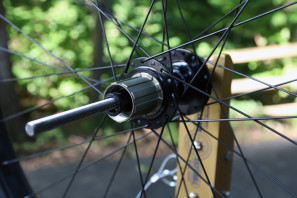
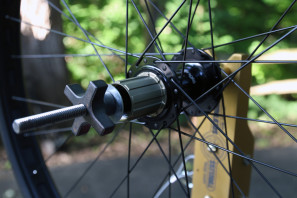
Making use of the incredibly well thought out adapter, Thru Axle hubs of any shape or size (with the exception of a Lefty) should fit without issue. Key to the design is a threaded axle that first attaches to the wheel support with a quick release of its own. The hub then slides onto the threaded support rod which is 9.5mm in diameter and effectively 230mm long. After a washer is installed to protect the hub, the lock nut slides all the way on thanks to the way the threads are cut. Tilting the lock nut to one side causes the opposing threads to disengage. Once you’ve positioned it close to the hub, tilt it the other way, engage the threads, and tighten it down. Because of the design of the lock nut you can flip the wheel from one side to the other in about 10 seconds.
Due to the length of the thru axle adapter it will fit the widest 197×12 mm hubs which makes the Tubeless Tower Fat Bike compatible. The only thing we wished for with the prototype was a bit more height out of the stand, but Tubeless Solutions says that issue has already been addressed and the production stand will sit at least an inch higher.
There is even a wheel truing adapter that will be available which functions like many single sided truing tools. One end secures to the hub (either under the thru axle nut, or in place of the Hook Tool for QR wheels) and the other end provides an adjustable, spring loaded feeler gauge to make simple adjustments to the wheel. The adapter also includes a rotor truing indicator which is where the slotted Hook Tool comes in.
While the rim clips and rim clip tire tools are still just 3D printed prototypes, they are interesting little devices that should help with ornery tires. Starting with one clip on the rim, you continue to install the tire until the addition of a second clip can be used to hold the tire in place providing a pocket to pour in the sealant. Once you’re done adding the sealant they are easily removed so you can continued the process of installing the tire. The tire tool adds just that – a tool that will help slide stubborn tires onto the rim.
Over the years in shops and on my personal bikes, I’ve probably seated and converted at least a thousand tubeless tires, all of which without any kind of workstation or special tools other than an air compressor.
Naturally my first question was what problem does this solve? Who is it for?
Quite simply, the Tubeless Tower makes the process easier and maybe above all else, it makes it cleaner. Short of a full on tire explosion, any excess sealant will drip down into the catch tray below the tire. I’m usually pretty clean on my installs, but even a few drops on your clothes, shoes, carpet, etc. can be a pain. The catch pan also acts as a reservoir for soapy water which we’ll get to in a second.
In addition to making the process cleaner, the Tubeless Tower makes it quite a bit easier since the wheel is firmly clamped into a stand. No pressing the hub against the shop floor, or the work bench to get the bead over the lip. Also, because the stand can be positioned at workbench height, it puts the wheel in position that’s easier to work with, easier to see, and doesn’t require you to support the wheel at the same time you’re trying to wrestle the tire over the rim. With that in mind, Tim tells us that users like Lennard Zinn who also has a prototype stand likes to use it for any tight rim and tire combination, not just for tubeless tires.
And when it comes to inflating the tires, because the wheel is supported by the hub and not resting on part of the tire, it seems to seat better and more quickly. In this case, both of our WTB Trail Boss 27.5 x 2.8″ tires seated to the Sun Ringle MuleFut SL 50 rims with a Birzman floor pump. Once the tire has been seated, you can pull the pin out of the wheel support and lay the wheel flat. That allows you to use the included brush (dipped in the soapy water mentioned earlier) and trace the rim and sidewall to find any pinhole leaks. It also allows the sealant to pool on the side of the rim/bead/sidewall of the tire while you spin it for better sealing action. This is all part of providing shops the ability to offer a wheel that they know has sealed before it leaves the shop.
Because of that, Tim tells us that he has taken shops in Kansas that previously stayed away from tubeless conversions and after training them on the Tubeless Tower, they’ve turned into the place to get your tubeless fix.
Really aimed at more of a shop level product, the pricing for the Tubeless Tower is still being finalized but for the kit seen above Tim expects it to come in around $500-600. One of their goals has always been to produce the workstations in Kansas and they are working to make the rim clips and tire tools in Kansas as well. Tim admits they could make it cheaper, but it would be exactly that. The first model will be effectively the Pro Model with a more affordable version down the line if things go well. That price may very well keep it out of reach for most consumers, but in addition to shops we could see a number of race teams picking one of these up to bring to events.
If you’re looking for the decidedly pro way of installing tubeless tires, Tubeless Solutions seems to be onto the answer.
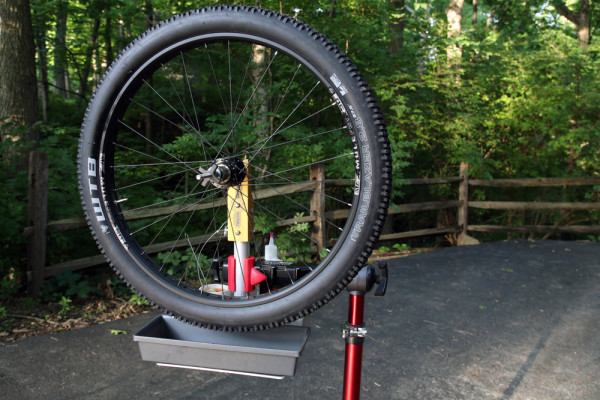
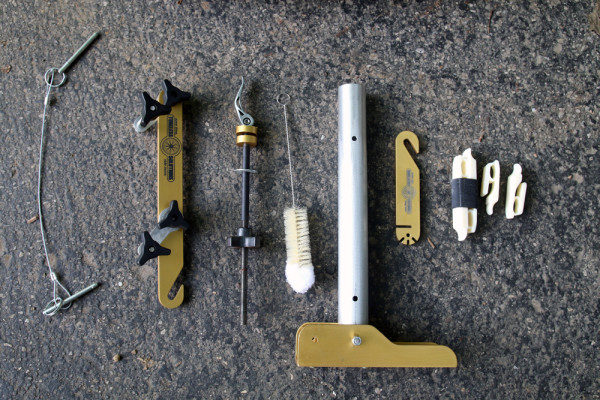
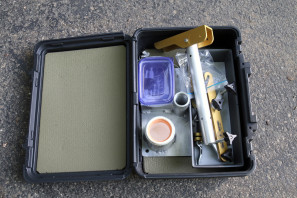
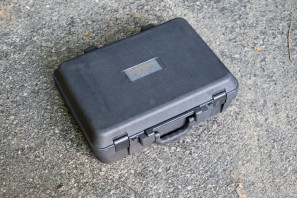
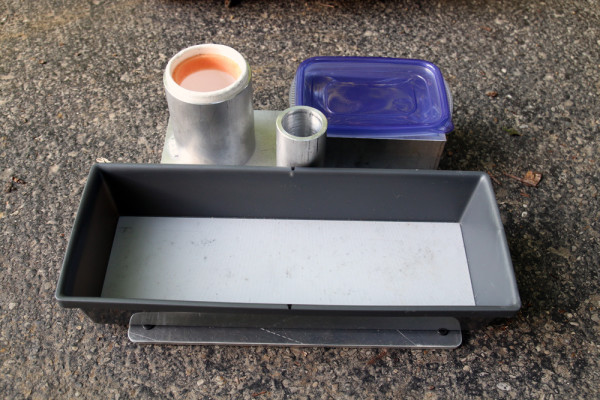
![IMG_20150717_022221531[1]](https://bikerumor.com/wp-content/uploads/2015/07/IMG_20150717_0222215311-338x600.jpg)
![IMG_20150717_021520605[1]](https://bikerumor.com/wp-content/uploads/2015/07/IMG_20150717_0215206051-338x600.jpg)
